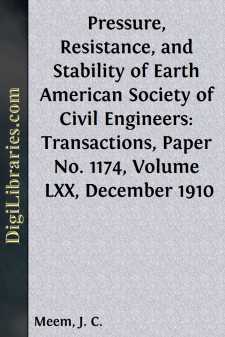Categories
- Antiques & Collectibles 13
- Architecture 36
- Art 48
- Bibles 22
- Biography & Autobiography 813
- Body, Mind & Spirit 142
- Business & Economics 28
- Children's Books 16
- Children's Fiction 13
- Computers 4
- Cooking 94
- Crafts & Hobbies 4
- Drama 346
- Education 46
- Family & Relationships 57
- Fiction 11829
- Games 19
- Gardening 17
- Health & Fitness 34
- History 1377
- House & Home 1
- Humor 147
- Juvenile Fiction 1873
- Juvenile Nonfiction 202
- Language Arts & Disciplines 88
- Law 16
- Literary Collections 686
- Literary Criticism 179
- Mathematics 13
- Medical 41
- Music 40
- Nature 179
- Non-Classifiable 1768
- Performing Arts 7
- Periodicals 1453
- Philosophy 64
- Photography 2
- Poetry 896
- Political Science 203
- Psychology 42
- Reference 154
- Religion 513
- Science 126
- Self-Help 84
- Social Science 81
- Sports & Recreation 34
- Study Aids 3
- Technology & Engineering 59
- Transportation 23
- Travel 463
- True Crime 29
Pressure, Resistance, and Stability of Earth American Society of Civil Engineers: Transactions, Paper No. 1174, Volume LXX, December 1910
by: J. C. Meem
Categories:
Description:
Excerpt
With discussion by Messrs. T. Kennard Thomson, Charles E. Gregory, Francis W. Perry, E.P. Goodrich, Francis L. Pruyn, Frank H. Carter, and J.C. Meem.
In the final discussion of the writer's paper, "The Bracing of Trenches and Tunnels, With Practical Formulas for Earth Pressures," certain minor experiments were noted in connection with the arching properties of sand. In the present paper it is proposed to take up again the question of earth pressures, but in more detail, and to note some further experiments and deductions therefrom, and also to consider the resistance and stability of earth as applied to piling and foundations, and the pressure on and buoyancy of subaqueous structures in soft ground.
In order to make this paper complete in itself, it will be necessary, in some instances, to include in substance some of the matter of the former paper, and indulgence is asked from those readers who may note this fact.
Fig. 1.
Experiment No. 1.—As the sand-box experiments described in the former paper were on a small scale, exception might be taken to them, and therefore the writer has made this experiment on a scale sufficiently large to be much more conclusive. As shown in , wooden abutments, 3 ft. wide, 3 ft. apart, and about 1 ft. high, were built and filled solidly with sand. Wooden walls, 3 ft. apart and 4 ft. high, were then built crossing the abutments, and solidly cleated and braced frames were placed across their ends about 2 ft. back of each abutment. A false bottom, made to slide freely up and down between the abutments, and projecting slightly beyond the walls on each side, was then blocked up snugly to the bottom edges of the sides, thus obtaining a box 3 by 4 by 7 ft., the last dimension not being important. Bolts, 44 in. long, with long threads, were run up through the false bottom and through 6 by 15 by 2-in. pine washers to nuts on the top. The box was filled with ordinary coarse sand from the trench, the sand being compacted as thoroughly as possible. The ends were tightened down on the washers, which in turn bore on the compacted sand. The blocking was then knocked out from under the false bottom, and the following was noted:
As soon as the blocking was removed the bottom settled nearly 2 in., as noted in , due to the initial compacting of the sand under the arching stresses. A measurement was taken from the bottom of the washers to the top of the false bottom, and it was noted as 41 in. (). After some three or four hours, as the arch had not been broken, it was decided to test it under greater loading, and four men were placed on it, four others standing on the haunches, as shown in . Under this additional loading of about 600 lb. the bottom settled 2 in. more, or nearly 4 in. in all, due to the further compression of the sand arch. About an hour after the superimposed load had been removed, the writer jostled the box with his foot sufficiently to dislodge some of the exposed sand, when the arch at once collapsed and the bottom fell to the ground.
Referring to , if, instead of being ordinary sand, the block comprised within the area, A U J V X, had been frozen sand, there can be no reason to suppose that it would not have sustained itself, forming a perfect arch, with all material removed below the line, V E J, in fact, the freezing process of tunneling in soft ground is based on this well-known principle.
...

